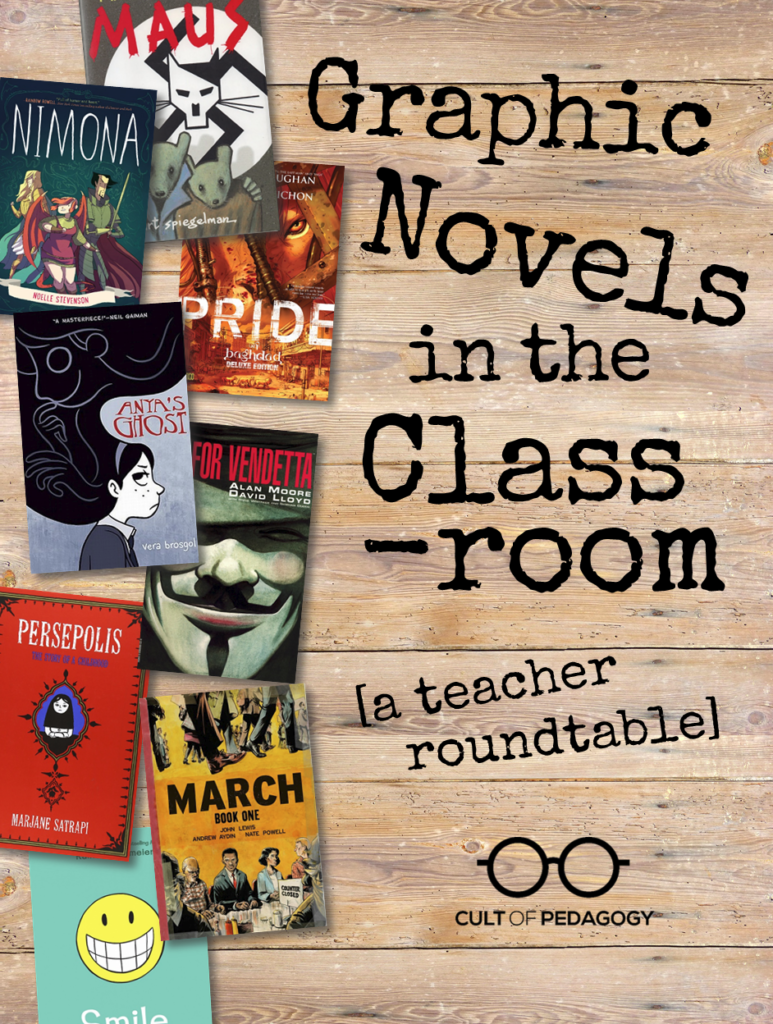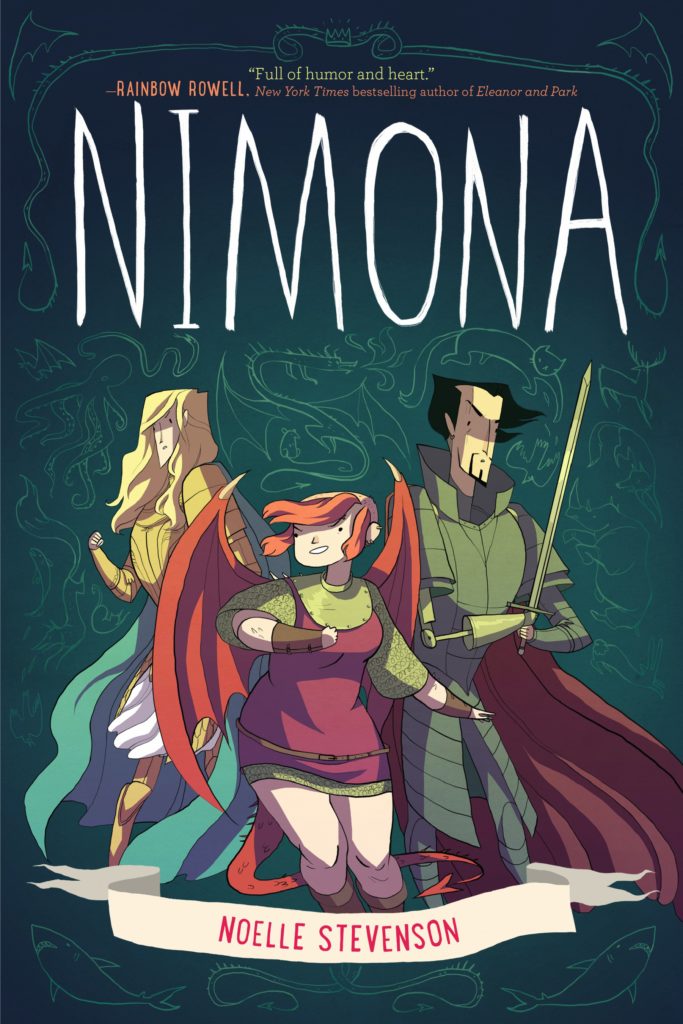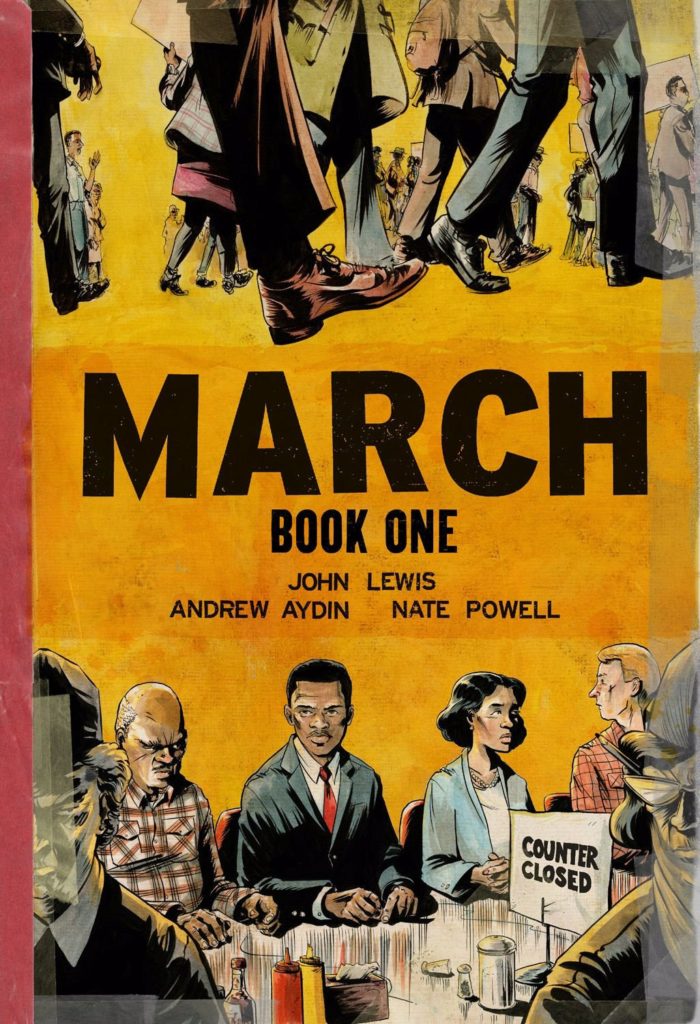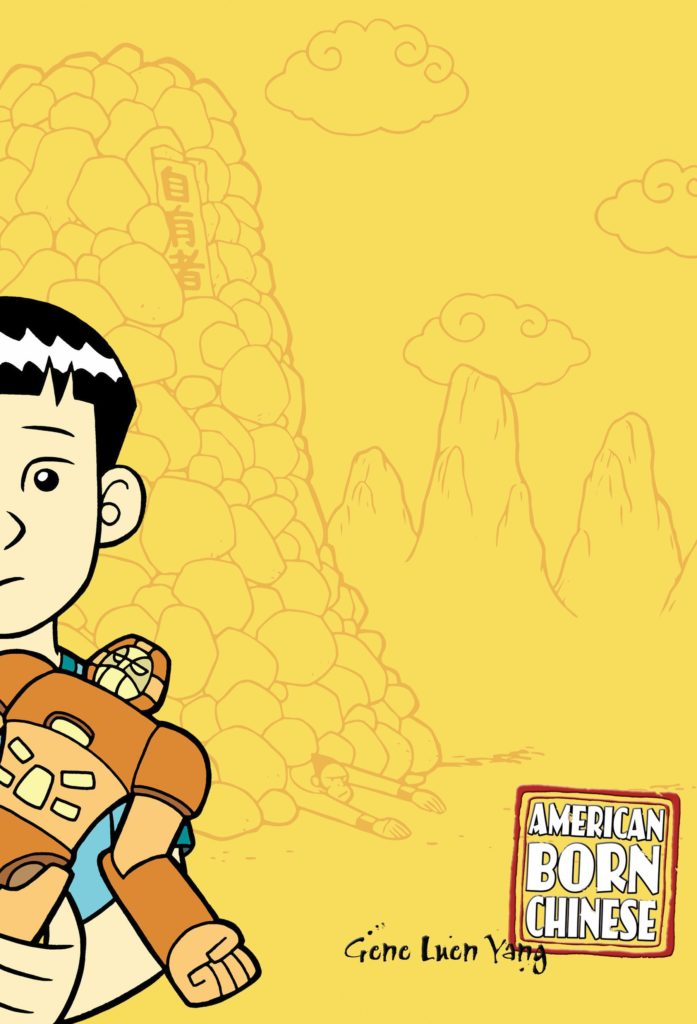Graphic Novels in the Classroom: A Teacher Roundtable

The links in this post are Amazon Affiliate links. If you click these and make a purchase from Amazon, Cult of Pedagogy will receive a small commission at no extra cost to you.
About a month ago, I shared an Edudemic post on my Facebook page about teaching with graphic novels, and I was startled by how many teachers responded to it. They talked about their own successful practices with graphic novels, shared how the books had transformed reluctant readers into obsessive readers, and they recommended dozens of titles—I’d never heard of most of them, but as soon as I took a look inside each one, I wanted to get my hands on them immediately. I quickly realized that any teacher who wants students to become avid readers should stock its library full of these gems.
I invited four of those teachers here for my first-ever Teacher Roundtable, where classroom teachers will share their thoughts and best practices on a specific topic. Today’s topic? Yep. Graphic novels.
Question 1: Why are graphic novels and comics valuable learning tools?
 Alison Walthew, English teacher, Yew Chung International School, Century Park Campus, Shanghai
Alison Walthew, English teacher, Yew Chung International School, Century Park Campus, Shanghai
The graphic novel (a good one) has depth of plot, character development, theme, etc. In short, it has the classic areas of study found in a prose text. It also has the elements of film we study with students, allowing them to develop literacy in the interpretation of image for meaning. When students combine both aspects to investigate a text’s effect on readers, they develop varied insights into how meaning is communicated and interpreted. It makes for a very rich literature study.
 Dr. Michelle Falter, Assistant Professor of English Education, North Carolina State University; former middle and high school English teacher and instructional coach
Dr. Michelle Falter, Assistant Professor of English Education, North Carolina State University; former middle and high school English teacher and instructional coach
First of all, the fact that they are multimodal (meaning multiple modes of expression are used) facilitates and supports students’ ability to visualize and understand complicated ideas, which is also a 21st century literacy skill. Secondly, because of the multimodality of the texts, they are manageable for students to read. It reduces the overall text load, therefore decreasing anxieties students might have regarding print-based reading. Third, they are relevant, engaging, and positive. It is easier for students to relate to a text when they can see it. It captures student interest in this increasingly visual world, which then also increases student motivation and desire to keep reading because they can be successful at it, therefore promoting a positive association to reading. Finally, graphic novels are cross-curricular; there are many connections that can be made across the curriculum in a variety of different subject matters.
 Beth Gillis, 6th grade humanities teacher, Sea Crest School, Half Moon Bay, CA
Beth Gillis, 6th grade humanities teacher, Sea Crest School, Half Moon Bay, CA
I first noticed the power of graphic novels with my struggling 5th and 6th grade readers. As a visual learner myself, I wasn’t surprised that they were drawn to graphics. The wording felt more approachable, the images supported their comprehension, and they felt the success of finishing books in a timely manner in a way they weren’t typically experiencing. When I took a motorcycle safety course years ago, the instructor shared that driving a motorcycle would turn us into safer, smarter, more aware drivers when we were in our cars. In this same way, explicitly teaching the elements of graphic novels has helped many of my students to become stronger readers with more traditional texts. They pay more attention to what authors state explicitly and where they need to infer or read between the lines to come up with details or bigger ideas. They think about the choices authors have made. They have a stronger sense of characters by asking themselves to paint a picture of all the visuals that aren’t present in traditional books. Michelle mentioned 21st century literacies above; I have incorporated a great deal of media literacy and critical literacy into my humanities classes as we think about power/voice/bias/perspective/etc. Graphic novels have added another layer to these lessons, and I’ve found the visual elements can support struggling students to engage in this work with more ease.
 Becky Greenhow, Elementary school teacher (grades 4-7), British Columbia
Becky Greenhow, Elementary school teacher (grades 4-7), British Columbia
Yes, yes and yes to all the above. I would like to add to Michelle and Beth’s comments about struggling readers. My daughter decided in Grade 3 that she was not going to read chapter books because she could not read chapter books. This past summer, prior to entering Grade 8, she said she loved reading. Graphic novels have given this reluctant reader a sense of accomplishment and pride. She’s been able to tackle a piece of literature with confidence, because of the above-mentioned elements unique to graphics that she IS good at: visual thinking, inferencing, modern artistic appreciation, creative thinking, and the art of storytelling (she’s a talker!). Also, there are many graphics who have strong female characters at their centre, thus attracting girl readers and giving them social “permission” to read comics, which hasn’t always been the case. In my day, girls who read comics were a little left of centre. Now it’s totally acceptable for a girl to be seen reading a graphic novel or comic. This helps my girl want to continue reading, since she’s not viewed as weird by her peers.
Graphics are also fabulous for tackling sensitive, difficult, or meaty topics (relationships, Shakespeare, etc.) that are often difficult for teens to want to discuss with adults. The visual nature and format of graphics makes such topics more relatable and makes students more connected to the piece.
The quality of characters is one criterion I look for when purchasing a new novel (like Alison listed above). Females in graphics (comics especially) are often portrayed with unrealistic bodies, shallow personalities, and in the shadow of their male counterparts. Good graphics don’t do that. They build up female characters, showing them as strong, dynamic, interesting, realistic. Important perspectives for both girls and boys to learn in school.
Question 2: What misconceptions do people have about graphic novels and comics?
Alison Walthew: Many teachers believe comics and graphic novels are the same. Essentially, they are, but a good graphic novel is not an Archie and whatever-her-name-was comic. It has layers of meaning like a good prose text. You wouldn’t choose to teach a Mills and Boon novel in an academic programme. In similar vein, you wouldn’t teach a silly comic as a novel.
Michelle Falter: I think a lot of people see graphic novels as a cop out to reading traditional print-based texts. In other words, it’s kind of cheating to give kids pictures and words. There is a stereotype that graphic literature is a lesser form of writing. This is absolutely untrue. The tasks and thinking skills required to read a multimodal text are actually higher level than if reading a print-based text alone. You have to see images and words work together, and when and why authors chose to put them together in a frame. I also think people think graphic novels are for ELL or elementary and middle grades students only. Although they are definitely very helpful for these students, this misconception comes from the fact that people see this genre as “easy”—and it is not.
Beth Gillis: I would agree with Michelle. I’ve had a few experiences where parents were highly concerned that their kids (often struggling readers) were choosing graphic novels, and that somehow this would slow down their learning or that it wasn’t “real” reading. Although I do think it’s important to insist on varying what kids are choosing throughout the year, if the alternative is to never finish a book, I’ll put graphic novels in their hands every time. I’ve been lucky to work in settings where parents have trusted my expertise as a literacy teacher, so I feel like I’ve always been able to confidently talk them down from these misguided beliefs. I’ve also had strong students who love to read, but who have never read a graphic novel (nor thought of it as a viable reading option). Many of them are pleasantly surprised to discover that they love the experience and end up choosing them more regularly as independent reading once the unit is over.
Becky Greenhow: I’ve had similar experiences as Beth, with parental concerns about easy reading vs real reading. When I know a student well, I can make recommendations towards more novels, or more non-fiction, or more current events. But if a child is a reluctant reader and gets joy from reading a graphic, LET THEM READ THE GRAPHIC. The main purpose in having kids learn to read in early elementary school is have them learn to have a positive relationship with text. If the relationship is not positive, then the struggle will be real for them in our text-based world.
Question 3: Share one of your favorite graphic novels or comics to teach, and talk about the lesson/unit you used it in.
[Editor’s Note: Teachers should preview these books before giving them to students. Some include content that may be considered inappropriate for younger students. When in doubt, see if Amazon has suggested an age range for the book or enter the title into the search bar on Common Sense Media to see their recommended minimum age.]
Alison Walthew: I have only taught V for Vendetta. By the way, the movie is terrible. It must not be shown to students if you are studying the novel. I started the novel off by telling the students to write out in prose exactly what information they got on the first page. They had to include everything as if it were the first page of a prose novel. The characters needed to be described, their facial expressions, the surroundings, etc. It was discovered that the page was jam-packed with information, even though there were very few words. This was to make them aware of the rich medium that is a graphic novel. They found they needed film technique words, as well, to try to describe how the visual conveyed meaning. The juxtaposition of graphic novel page and written text only was powerful.
Michelle Falter: How do I choose one? I love so many. I think I will focus on one that maybe people are less familiar with: Pride of Baghdad. The story is about a pride of lions that escaped the Baghdad Zoo during an American bombing raid. It could work in both middle and high school English or social studies class. I have used this book as an ELA teacher to talk about symbolism, personification, imagery. The themes of freedom and alienation are big in this book. Also the anthropomorphism of the animals is particularly interesting. Because it deals with concepts of right and wrong and the consequences of war, rich discussion and debate occur.
Beth Gillis: My favorite book to use as a mentor text with my graphic novel unit is March, Book 1. Since I’m teaching in a humanities model, it’s always a win to find books that complement our social studies units. My reading-based lessons begin with the elements of graphic novels: layout and how to read the panels in the correct order, author’s choice around font/size/placement of words/how big or small or plentiful (or varied) the panels are on the pages, powerful “moves” that authors make to shift the tone or emphasis (having one sole picture on a page spread, using black and negative space, the absence of pictures and what that might represent). I almost always use the content for more traditional reading lessons around comprehension, especially to support struggling readers, but also often connect the content back to our community or to draw parallels with social studies or current events.
In the first year that we used March, the Black Lives Matter movement was really starting to surface in the mainstream media. I was working in a school in San Francisco where many students were aware of the inequities around them, but still felt quite disconnected with their personal experiences in a mostly privileged community. One of my students went to Union Square for the Christmas tree lighting and saw a group of BLM folks protesting on the square. He came back to school the next day and asked if we could talk about what was happening. We had been raising awareness around Ferguson, Michael Brown and the regular shootings of black American males by the police throughout the fall, but his experience that night helped our conversations feel more real. It also ignited an activist spirit within him that has become a big part of his identity.
All throughout these events, we were reading March, drawing parallels to the Civil Rights Movement of the 60’s and what we were seeing in present-day current events. At one point, that student made an observation that many people look back to the Civil Rights era and imagine how they might be different if they were living at the time. “So now you have the chance to be that person today. Who will you be?” he challenged his classmates. I remember having that warm and fuzzy feeling that we teachers get when the stars align and the class is pure magic. The visuals in the book made the history come to life in a way that couldn’t have otherwise happened for many of my students.
Becky Greenhow: I got interested in graphic novels due to my daughter’s reading disability and her abhorrence of literature (GASP! I know!). Despite having a very large YA fiction collection of my own, I was inexperienced with the graphic genre, and wanted something that would engage students (my daughter especially) with high interest/ age appropriate content, low vocab, visual cues for comprehension, and strong (mostly girl) heroes. Thus was born our graphic collection! PS: Most of our collection has accumulated in the last 3 years, when I have not been employed in a school. Therefore my teaching of graphic novels in a classroom setting is limited.
Question 4: What other books have you and your students loved?
Alison Walthew: Colleagues have taught Persepolis (story of a young girl growing up in Iran before and after the Islamic Revolution) and Maus (story of the Nazis and the Jews during WWII, but using cats and mice to depict them). The books have been used in the Language A: Language and Literature International Baccalaureate course. This is an external essay exam in which a question is addressed, using two texts, and investigating style and context as well as the usual literature elements. The graphic novel lends itself to this as the difference between prose and graphic style can add to the discussion.
Michelle Falter: Like Alison, both Persepolis and Maus were highly impactful reads for my students. Myself and a colleague have put together a list of Graphic Novel Recommendations for middle or high school teachers that deal with social justice topics. This list is by no means exhaustive or inclusive of every great book out there, but we are happy to share it.
Beth Gillis: Thank you for that list, Michelle! We fly through titles in book club-style during our unit, so I don’t explicitly teach these books, but I’ve heavily vetted them for their content, quality and diverse representation (which is even more difficult with graphic novels than traditional as main characters in the middle grades/middle school levels tend to be white females.) I’m also always on the lookout for approachable, high-interest nonfiction graphic novels. My students have loved/are loving:
- All things Reina Telgemeier (Smile, Sisters, Drama, Ghosts)
- Princeless: Save Yourself
- Human Body Theater
- Primates
- Lumberjanes
- El Deafo
- Sunny Side Up
- Awkward
- Rapunzel’s Revenge and Calamity Jack
- Anything Doug TenNapel (Cardboard, Ghostopolis, Bad Island)
- Anya’s Ghost
- Roller Girl
- The Odyssey
Michelle Falter: To add onto Beth’s comments, I absolutely love Anya’s Ghost by Vera Brosgol, and all of Reina Telgemeier’s novels are brilliant. Three more graphic novels that are pretty new that I have personally loved and would love to see someone teach are Trashed by Derf Backderf about the untold story of garbage collectors and what happens to all the trash we throw away, The Encyclopedia of Early Earth: A Novel by Isabel Greenberg, a sort of mythological tale, and The Gigantic Beard That Was Evil by Stephen Collins, a really interesting allegory about conformity, fear, and hate.
Becky Greenhow: Thanks Michelle! For the list and additions. Yes! Everything in Beth’s list. Here are some more from our house:
- O’Connor’s Olympians books: Good for Grade 7 “Ancient Civilizations”; myths and legends
- Stevenson’s award-winning Nimona: strong female hero
- Gulledge’s Page by Paige: “empowering exploration of art, identity, and finding one’s voice”
- Any of the classic book adaptations: The Hobbit, The Call of the Wild, A Wrinkle in Time
- Any of the modern book adaptations: Artemis Fowl, The City of Ember, Coraline, The Lightning Thief
- And if you are wanting to investigate a genre hybrid, check out RED: A Haida Manga by Michael Nicoll Yahgulanaas
UPDATE: I have found versions of several of these books in Spanish as well!
Question 5: What does a teacher need to do to be successful with graphic novels? Are there any Do’s and Don’ts?
Alison Walthew: I do think a review of film technique will assist in making the teacher aware of the use of colour, angles, framing, foregrounding and backgrounding, etc. These aspects need to be addressed in any analysis of the graphic novel.
Michelle Falter: I highly recommend purchasing Scott McCloud’s book, Understanding Comics: The Invisible Art. He really is the guru of getting to know this genre. I have found the book extraordinarily helpful. Personally, I think the worst thing you could do with teaching a graphic novel is teach it like a print-based text. If you just focus on the story, and not on how the story is constructed through frames, colors, angles, word bubbles, etc., you are missing the point. Teaching Strategies for Graphic Novels, which I found by accident at some point, is a great free resource for thinking about activities to do with graphic novels; it comes from getgraphic.org, which also has a ton of wonderful resources for teachers and librarians. If teaching an entire graphic novel seems scary, there are also many wonderful classic novels that have been retold in graphic novel format that would be a great way to start, as a companion piece to the original telling. A good example of a classic retold in graphic novel format is A Wrinkle in Time.
Beth Gillis: Agreed re: Understanding Comics. The best thing a teacher can do is to educate themselves on the elements and components of comics/graphic novels so that they can use that knowledge for the end goal: teaching students to recognize those elements and make sense of them in a literary context. I took a graduate class on teaching with graphic novels with a fabulously quirky and passionate comic lover, Stephen Cary, in the last semester before he retired. He wrote Going Graphic: Comics at Work in the Multilingual Classroom, which I found to be super informative, even though I don’t work with ELL students.
Becky Greenhow: Thank you for the suggestions regarding learning about graphics as a purposeful genre, and not just a different format in which to insert traditional text and story. Future references, for sure! ♦
Do you teach with graphic novels? Share your thoughts and best practices in the comments below. And if you’re still getting started, ask questions so the community can help you out!
Join my mailing list and get weekly tips, tools, and inspiration all geared toward making your teaching more effective and fun. You’ll also get access to my members-only library of free resources, including my e-booklet, 20 Ways to Cut Your Grading Time in Half, which has helped thousands of teachers spend less time grading!



